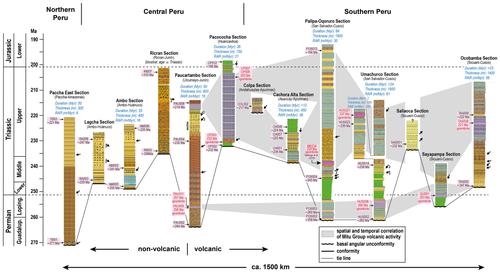当前位置:
X-MOL 学术
›
Basin Res.
›
论文详情
Our official English website, www.x-mol.net, welcomes your
feedback! (Note: you will need to create a separate account there.)
Sedimentology, geochronology and provenance of the late Permian and Triassic Mitu Group in Peru—The evolution of continental facies along a transform margin
Basin Research ( IF 2.8 ) Pub Date : 2024-04-16 , DOI: 10.1111/bre.12864 Fernando Panca 1 , Heinrich Bahlburg 1 , José Cárdenas 2 , Jasper Berndt 3 , Nils Keno Lünsdorf 4 , Axel Gerdes 5
Basin Research ( IF 2.8 ) Pub Date : 2024-04-16 , DOI: 10.1111/bre.12864 Fernando Panca 1 , Heinrich Bahlburg 1 , José Cárdenas 2 , Jasper Berndt 3 , Nils Keno Lünsdorf 4 , Axel Gerdes 5
Affiliation

|
In the late Permian and Triassic, the continental Mitu Group formed in extensional basins along the length of the Cordillera Oriental and Altiplano of present‐day Peru. Given the presence of coeval arc systems only in northern Chile and southern Ecuador but not in Peru the tectonic setting of the Mitu basin has been interpreted variably as orthogonal continental rift, sinistral transtensional rift, aulacogen and back‐arc basin. The Mitu Group comprises continental mass flow and alluvial fan, fluvial, aeolian and minor lacustrian facies and hosts thick piles of subalkaline and alkaline intermediate and felsic ignimbrites and mafic lavas. The age of the Mitu Group had originally been established as ranging from the Late Permian to the late Triassic on the basis of structural considerations and scarce biostratigraphic data. Recently, U–Pb zircon ages from ignimbrites and sedimentary rocks have been taken to constrain the Mitu Group to the Middle and Late Triassic. We performed a sedimentological, heavy mineral, and zircon geochronological and Lu‐Hf isotope study of the Mitu Group in 14 sections mainly in southern and central Peru, and one section in northern Peru. Ten new U–Pb concordia ages on ignimbrites intercalated in the Mitu Group successions offer a new robust stratigraphic framework and constrain the stratigraphy of the Mitu Group between 260 and 205 Ma. In combination with maximum likelihood ages of deposition derived from detrital zircon, U–Pb geochronology places the deposition of the Mitu Group between ca. 270 and 194 Ma (lower Guadalupian into the Sinemurian). Detrital zircon U–Pb age distributions and heavy mineral assemblages reflect a strongly recycled Precambrian Amazonian and Palaeozoic proto‐Andean provenance. The Palaeozoic detrital age patterns are highly variable, and temporally and spatially random. A local provenance can generally not be identified. εHf(t ) values in zircon obtained from ignimbrites and sedimentary rocks indicate variable degrees of crustal recycling. In the course of the Palaeozoic, εHf(t ) values become on average progressively less negative, with a large proportion particularly of Mitu age zircons' εHf(t ) values encompassing less evolved and moderately juvenile compositions. Along strike of the basin stratigraphic thicknesses, and rates and times of accumulation vary strongly with larger thicknesses and rates being registered in southern Peru. This suggests that the Mitu basin had been divided into a number of subbasins with individual histories of subsidence, accumulation, and volcanism. Absent a magmatic arc, late Permian–Triassic Peru evolved in a sinistral plate tectonic and regional framework expressed particularly in the sinistral Late Gondwanide orogeny predating the Mitu Group. We interpret that a sinistral transform fault linked the subduction zones in southern Ecuador and northern Chile and that the Mitu Group basin has formed by sinistral transtensional and transpressional movements along a related transcurrent fault inboard of the transform margin. In the broader framework of the accretionary Terra Australis orogen along the western Gondwana margin, this interpretation fits its evolution in the Andean segment in an internally consistent way.
中文翻译:

秘鲁晚二叠世和三叠世米图群的沉积学、年代学和物源——沿转换边缘的大陆相演化
在二叠纪晚期和三叠纪,大陆米图群在沿着东科迪勒拉山脉和现今秘鲁高原的伸展盆地中形成。鉴于同时期弧系统仅在智利北部和厄瓜多尔南部存在,而在秘鲁不存在,米图盆地的构造背景被不同地解释为正交大陆裂谷、左旋转张裂谷、奥拉卡根和弧后盆地。米图群由大陆质流相、冲积扇、河流相、风成相和小型湖相组成,并含有厚厚的亚碱性和碱性中碱性、长英质凝结岩和镁铁质熔岩。米图群的年龄最初根据结构考虑和稀缺的生物地层数据确定为晚二叠世至晚三叠世。最近,来自火成岩和沉积岩的U-Pb锆石年龄被用来将米图群限制在中三叠世和晚三叠世。我们对主要位于秘鲁南部和中部的 14 个剖面以及秘鲁北部的一个剖面进行了米图群的沉积学、重矿物、锆石年代学和 Lu-Hf 同位素研究。米图群层序中插入的火成岩的 10 个新的 U-Pb 协和年龄提供了一个新的稳健的地层框架,并将米图群的地层限制在 260 至 205 Ma 之间。结合碎屑锆石沉积的最大似然年龄,U-Pb 地质年代学将米图群的沉积置于约270 和 194 Ma(瓜达卢普阶下段进入辛穆阶)。碎屑锆石 U-Pb 年龄分布和重矿物组合反映了强烈回收的前寒武纪亚马逊和古生代原安第斯物源。古生代碎屑年龄模式变化很大,并且在时间和空间上是随机的。通常无法确定当地出处。 εHf(t ) 从熔结岩和沉积岩中获得的锆石值表明了不同程度的地壳再循环。在古生代,εHf(t ) 值的负值平均逐渐减小,尤其是米图年龄锆石的 εHf(t )值包含进化程度较低和中等幼稚的成分。沿盆地走向的地层厚度、堆积速率和时间变化很大,秘鲁南部记录的厚度和速率较大。这表明米土盆地已被划分为许多具有各自沉降、堆积和火山作用历史的子盆地。由于没有岩浆弧,秘鲁在晚二叠世-三叠世演化出了左旋板块构造和区域框架,特别是在米图群之前的左旋晚冈瓦尼造山运动中。我们解释说,左旋转换断层连接了厄瓜多尔南部和智利北部的俯冲带,并且米图群盆地是由沿着转换边缘内侧的相关横流断层的左旋张拉和压扭运动形成的。在沿冈瓦纳大陆西部边缘增生的澳大利亚造山带的更广泛框架中,这种解释以内部一致的方式符合其在安第斯段的演化。
更新日期:2024-04-16
中文翻译:

秘鲁晚二叠世和三叠世米图群的沉积学、年代学和物源——沿转换边缘的大陆相演化
在二叠纪晚期和三叠纪,大陆米图群在沿着东科迪勒拉山脉和现今秘鲁高原的伸展盆地中形成。鉴于同时期弧系统仅在智利北部和厄瓜多尔南部存在,而在秘鲁不存在,米图盆地的构造背景被不同地解释为正交大陆裂谷、左旋转张裂谷、奥拉卡根和弧后盆地。米图群由大陆质流相、冲积扇、河流相、风成相和小型湖相组成,并含有厚厚的亚碱性和碱性中碱性、长英质凝结岩和镁铁质熔岩。米图群的年龄最初根据结构考虑和稀缺的生物地层数据确定为晚二叠世至晚三叠世。最近,来自火成岩和沉积岩的U-Pb锆石年龄被用来将米图群限制在中三叠世和晚三叠世。我们对主要位于秘鲁南部和中部的 14 个剖面以及秘鲁北部的一个剖面进行了米图群的沉积学、重矿物、锆石年代学和 Lu-Hf 同位素研究。米图群层序中插入的火成岩的 10 个新的 U-Pb 协和年龄提供了一个新的稳健的地层框架,并将米图群的地层限制在 260 至 205 Ma 之间。结合碎屑锆石沉积的最大似然年龄,U-Pb 地质年代学将米图群的沉积置于约270 和 194 Ma(瓜达卢普阶下段进入辛穆阶)。碎屑锆石 U-Pb 年龄分布和重矿物组合反映了强烈回收的前寒武纪亚马逊和古生代原安第斯物源。古生代碎屑年龄模式变化很大,并且在时间和空间上是随机的。通常无法确定当地出处。 εHf(






























 京公网安备 11010802027423号
京公网安备 11010802027423号